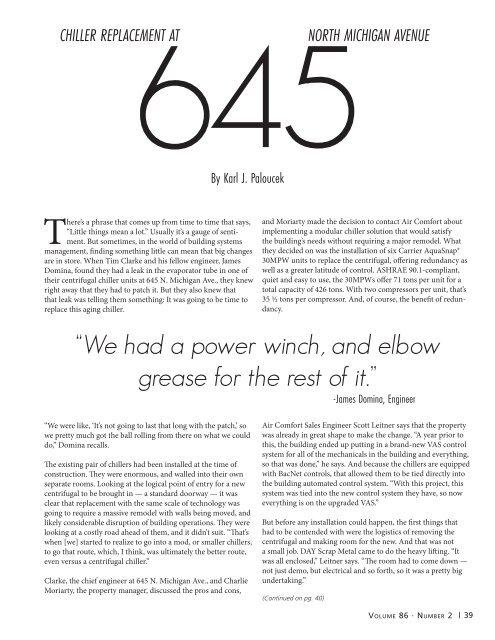CEAC-2021-02-February
You also want an ePaper? Increase the reach of your titles
YUMPU automatically turns print PDFs into web optimized ePapers that Google loves.
CHILLER REPLACEMENT AT<br />
645NORTH MICHIGAN AVENUE<br />
By Karl J. Paloucek<br />
There’s a phrase that comes up from time to time that says,<br />
“Little things mean a lot.” Usually it’s a gauge of sentiment.<br />
But sometimes, in the world of building systems<br />
management, finding something little can mean that big changes<br />
are in store. When Tim Clarke and his fellow engineer, James<br />
Domina, found they had a leak in the evaporator tube in one of<br />
their centrifugal chiller units at 645 N. Michigan Ave., they knew<br />
right away that they had to patch it. But they also knew that<br />
that leak was telling them something: It was going to be time to<br />
replace this aging chiller.<br />
and Moriarty made the decision to contact Air Comfort about<br />
implementing a modular chiller solution that would satisfy<br />
the building’s needs without requiring a major remodel. What<br />
they decided on was the installation of six Carrier AquaSnap®<br />
30MPW units to replace the centrifugal, offering redundancy as<br />
well as a greater latitude of control. ASHRAE 90.1-compliant,<br />
quiet and easy to use, the 30MPWs offer 71 tons per unit for a<br />
total capacity of 426 tons. With two compressors per unit, that’s<br />
35 ½ tons per compressor. And, of course, the benefit of redundancy.<br />
“We had a power winch, and elbow<br />
grease for the rest of it.”<br />
-James Domina, Engineer<br />
“We were like, ‘It’s not going to last that long with the patch,’ so<br />
we pretty much got the ball rolling from there on what we could<br />
do,” Domina recalls.<br />
The existing pair of chillers had been installed at the time of<br />
construction. They were enormous, and walled into their own<br />
separate rooms. Looking at the logical point of entry for a new<br />
centrifugal to be brought in — a standard doorway — it was<br />
clear that replacement with the same scale of technology was<br />
going to require a massive remodel with walls being moved, and<br />
likely considerable disruption of building operations. They were<br />
looking at a costly road ahead of them, and it didn’t suit. “That’s<br />
when [we] started to realize to go into a mod, or smaller chillers,<br />
to go that route, which, I think, was ultimately the better route,<br />
even versus a centrifugal chiller.”<br />
Clarke, the chief engineer at 645 N. Michigan Ave., and Charlie<br />
Moriarty, the property manager, discussed the pros and cons,<br />
Air Comfort Sales Engineer Scott Leitner says that the property<br />
was already in great shape to make the change. “A year prior to<br />
this, the building ended up putting in a brand-new VAS control<br />
system for all of the mechanicals in the building and everything,<br />
so that was done,” he says. And because the chillers are equipped<br />
with BacNet controls, that allowed them to be tied directly into<br />
the building automated control system. “With this project, this<br />
system was tied into the new control system they have, so now<br />
everything is on the upgraded VAS.”<br />
But before any installation could happen, the first things that<br />
had to be contended with were the logistics of removing the<br />
centrifugal and making room for the new. And that was not<br />
a small job. DAY Scrap Metal came to do the heavy lifting. “It<br />
was all enclosed,” Leitner says. “The room had to come down —<br />
not just demo, but electrical and so forth, so it was a pretty big<br />
undertaking.”<br />
(Continued on pg. 40)<br />
Volume 86 · Number 2 | 39


















